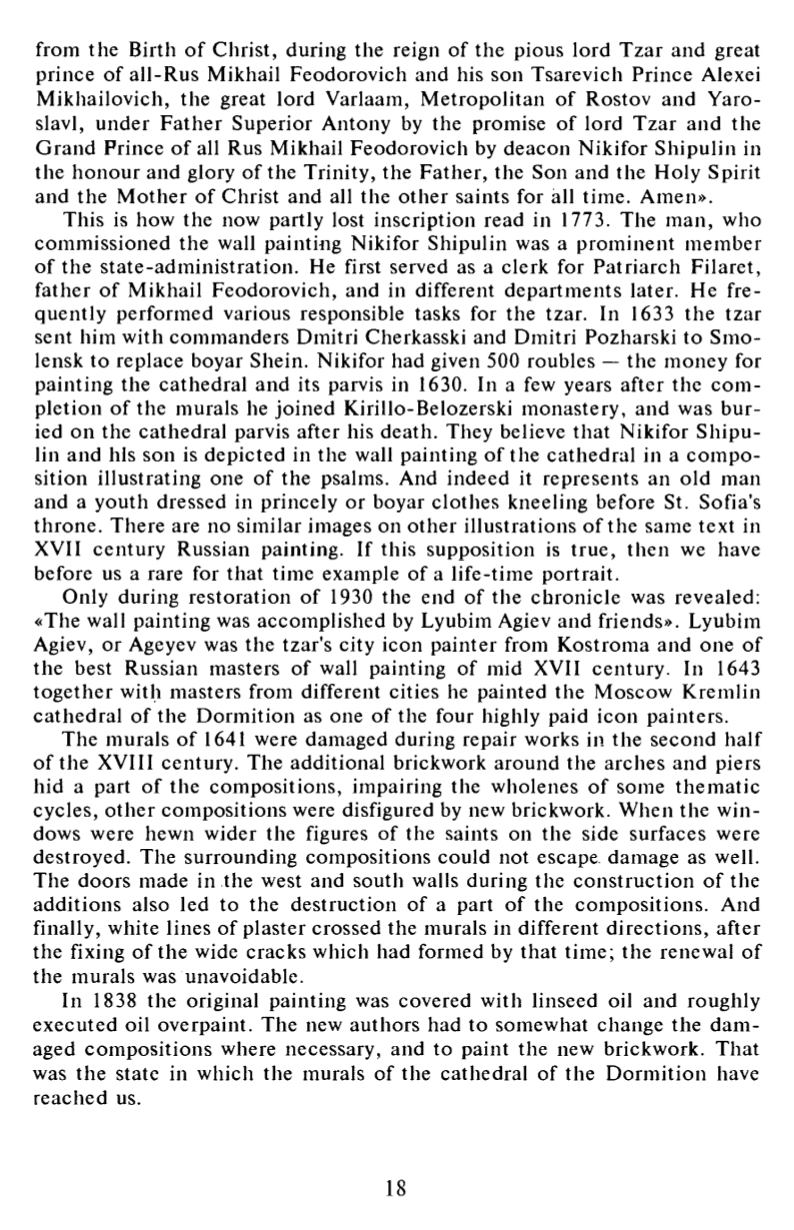

from the Birth o f Christ, during the reign of the pious lord Tzar and great
prince of all-Rus Mikhail Feodorovich and his son Tsarevich Prince Alexei
Mikhailovich, the great lord Varlaam, Metropolitan o f Rostov and Yaro
slavl, under Fa ther Superior Antony by the promise o f lord Tzar and the
Grand Prince o f all Rus Mikhail Feodorovich by deacon Nikifor Sh ipulin in
the honou r and glory of the Trinity, the Father, the Son and the Holy Spirit
and the Mo the r o f Christ and all the o ther saints for all time. Amen».
This is how the now partly lost inscription read in 1773. The man , who
commissioned the wall painting Nikifor Shipulin was a prominen t member
o f the state-admin istration . He first served as a clerk for Patriarch Filaret,
father o f Mikhail Feodorovich, and in different departmen ts later. He fre
quently performed various responsible tasks for the tzar. In 1633 the tzar
sent him with commanders Dmitri Cherkasski and Dmitri Pozharski to Smo
lensk to replace boyar Shein. Nikifor had given 500 roubles — the money for
painting the cathedral and its parvis in 1630. In a few years after the c om
p letion o f the murals he jo ined Kirillo-Belozerski monastery, and was bu r
ied on the cathedral parvis after his death. They believe that Nikifor Sh ipu
lin and his son is depicted in the wall painting o f the cathedral in a c om po
sition illustrating one of the psalms. And indeed it represents an old man
and a youth dressed in princely or boyar clothes kneeling before St. Sofia’s
th rone. There are no similar images on o ther illustrations o f the same text in
XVII cen tury Russian painting. If this supposition is true, then we have
before us a rare for that time example of a life-time portrait.
Only during restoration o f 1930 the end of the chron icle was revealed:
«The wall painting was accomplished by Lyubim Agiev and friends». Lyubim
Agiev, or Ageyev was the tzar's city icon painter from Kostroma and one of
the best Russian masters of wall painting of mid XVII century. In 1643
together with masters from different cities he painted the Moscow Kremlin
cathedral o f the Dormition as one of the four highly paid icon painters.
The murals o f 1641 were damaged during repair works in the second half
o f the XVIII century. The additional brickwork around the arches and piers
hid a part o f the compositions, impairing the wholenes o f some thema tic
cycles, o ther compositions were disfigured by new brickwork. When the w in
dows were hewn wider the figures of the saints on the side surfaces were
destroyed. The surrounding compositions could not escape damage as well.
The doors made in the west and south walls during the construc tion o f the
additions also led to the destruction of a part o f the compositions. And
finally, white lines of plaster crossed the murals in different directions, after
the fixing o f the wide cracks which had formed by that time; the renewal of
the murals was unavoidable.
In 1838 the original painting was covered with linseed oil and roughly
executed oil overpaint. The new authors had to somewhat change the d am
aged compositions where necessary, and to paint the new brickwork. That
was the state in which the murals of the cathedral of the Do rm ition have
reached us.
18















